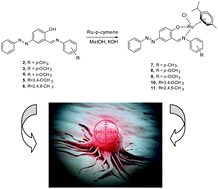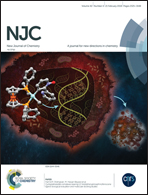Antiproliferative, antioxidant, computational and electrochemical studies of new azo-containing Schiff base ruthenium(ii) complexes†
Abstract
A new series of ruthenium(II) complexes 7–11 containing the –N![[double bond, length as m-dash]](https://www.rsc.org/images/entities/char_e001.gif) N– group are synthesized and characterized via elemental analysis, and IR, UV-visible and 1H–13C NMR spectroscopy. The solid-state structures of 2, 6 and 9 are determined by single crystal X-ray diffraction studies. The antiproliferative activities of the Schiff base ligands and their ruthenium(II) complexes are investigated in vitro against non-small cell lung cancer cells (H2126), prostate adenocarcinoma cells (PC3) and breast cancer cells (MCF7). The cell proliferation tests are performed as dose-dependent assays at eight concentrations, and 5-fluorouracil is used as the positive control. Compounds 4 and 5 show higher antiproliferative activities against PC3 cells than the other synthesized compounds. Furthermore, the antioxidant capacities of the Schiff base ligands and their ruthenium(II) complexes are investigated in vitro via ferric reduction power, DPPH free radical, and ABTS cation radical scavenging activity tests. The radical scavenging activities of complexes 7–11 are found to be higher than BHT, BHA, and Trolox, which are used as positive controls. The antioxidant activity of the complexes is found to be 30–150 fold higher than the ligands. According to obtained results, the ruthenium complexes in this study may be used as antioxidant agents in the food, drug and cosmetic industries.
N– group are synthesized and characterized via elemental analysis, and IR, UV-visible and 1H–13C NMR spectroscopy. The solid-state structures of 2, 6 and 9 are determined by single crystal X-ray diffraction studies. The antiproliferative activities of the Schiff base ligands and their ruthenium(II) complexes are investigated in vitro against non-small cell lung cancer cells (H2126), prostate adenocarcinoma cells (PC3) and breast cancer cells (MCF7). The cell proliferation tests are performed as dose-dependent assays at eight concentrations, and 5-fluorouracil is used as the positive control. Compounds 4 and 5 show higher antiproliferative activities against PC3 cells than the other synthesized compounds. Furthermore, the antioxidant capacities of the Schiff base ligands and their ruthenium(II) complexes are investigated in vitro via ferric reduction power, DPPH free radical, and ABTS cation radical scavenging activity tests. The radical scavenging activities of complexes 7–11 are found to be higher than BHT, BHA, and Trolox, which are used as positive controls. The antioxidant activity of the complexes is found to be 30–150 fold higher than the ligands. According to obtained results, the ruthenium complexes in this study may be used as antioxidant agents in the food, drug and cosmetic industries.



 Please wait while we load your content...
Please wait while we load your content...